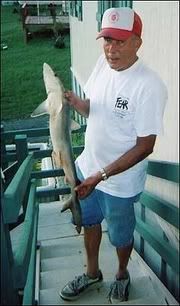jtexas
Fleet Admiral
- Joined
- Oct 13, 2003
- Messages
- 8,646
San Antonio Express News <br /><br /><br />
 <br />Jet Smith was stunned when he found a 36-inch sharpnose shark caught in one of his juglines. <br /><br /><br />
<br />Jet Smith was stunned when he found a 36-inch sharpnose shark caught in one of his juglines. <br /><br /><br />

shark mysteriously turns up at Medina Lake <br />Web Posted: 08/24/2005 12:00 AM CDT <br /><br />Ron Henry Strait<br />Express-News Staff Writer <br /><br />When Jet Smith went out to check his fishing lines on Sunday morning, the Medina Lake angler wasn't expecting to haul in a 3-foot-long shark. <br /> <br />All he was really after was enough catfish for supper, but what he brought to the dock an hour later was one catfish and one heck of a fish story. <br /><br />"I saw him coming up this way and he had two fish on the stringer," said Dot Smith, his wife. "One of them was so skinny." <br /><br />Jet Smith said that's about the way it went. "I walked up with that thing and she said, 'That sure is a skinny catfish.' I said, 'It's not a catfish. It's a shark.'" <br /><br />And not just any shark, either, but a 36-inch-long Atlantic sharpnose shark, a saltwater species that is biologically hundreds of miles out of its element in a Hill Country freshwater impoundment. <br /><br />Medina Lake, a 5,000-acre lake northwest of San Antonio, is about four hours from the Texas Coast. <br /><br />"I was rounding up my juglines, and I pulled up on this one and could feel something was on it," Smith said, "but it wasn't moving." <br /><br />Jugline fishing is done with a hook and line tied to a flotation device, like an empty milk jug. Each baited jugline is set free in the lake late in the day to move with winds and current during the night. <br /><br />Smith baited 10 juglines with live perch and set them out in the upper end of Medina Lake about sundown on Saturday, as he has done many evenings during the eight years he and Dot have lived on the lake. <br /><br />About 8 a.m. Sunday, Smith was picking up his juglines when, "I pulled the shark up. It looked fresh. The gills were still pink and it wasn't spoiled." <br /><br />A spoiled fish's eyes become milky looking, and this shark's eyes appeared clear. <br /><br />Jet got Dot to take a couple of photographs, but he was suspicious and didn't make much of a fuss. <br /><br />"I waited around Sunday for somebody to say something," Smith said. "If it was a prank, I think somebody would have said something." <br /><br />Nobody said anything. <br /><br />Meanwhile, Smith checked the Internet and found a place where, "It says sharks can adapt to freshwater." <br /><br />That's true to a limited extent, said Scott Nuñez, a physiologist and assistant professor of marine science at the University of Texas Marine Science Institute at Port Aransas. <br /><br />Nuñez looked at the e-mail photos and identified the shark as a mature male Atlantic sharpnose. <br /><br />"I'm continually amazed by nature," said Nuñez, who remains skeptical about the origins of the Medina Lake shark. <br /><br />He was reluctant to say that a saltwater shark species could survive in freshwater, except for the bull shark, which is known to enter freshwater coastal streams. <br /><br />According to Nuñez, a shark like the Atlantic sharpnose would experience rapid cellular ruptures and be dead within minutes of release into freshwater. <br /><br />As for the Smiths, their credentials appear more than reputable. <br /><br />Jet works for the Benedictine Sisters and Dot operates Hill Country Family Services in Kendall County. The agency finds funds to help the needy pay utility, rent and other bills. <br /><br />Like the scientist, the Smiths are dubious about how a shark could breath its last on the end of Jet's jugline. They have placed the fish in the freezer awaiting further developments. <br /><br />



















